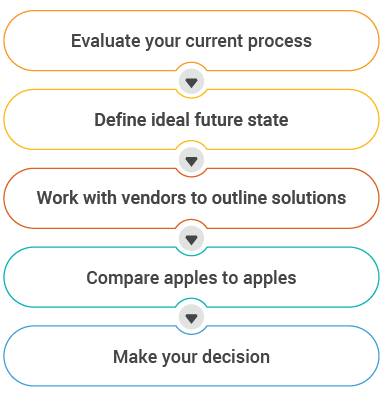Clinical data has evolved, and your
evaluation process should too.
EDC is the foundation of your data management efforts, but it is just one part of a growing clinical data landscape that requires several tools to collect the data you need. How do you choose the right EDC in this new environment?
A typical vendor evaluation process may not take into account the ever-increasing complexity of today’s clinical data landscape. Change is an opportunity to do things in a better way — but you have to be open to doing things differently in order to see different results.
These recommendations will help adjust your evaluation approach to get the solution you need in the modern clinical data landscape.
5 Steps for a Successful EDC


Step 1
Evaluate your current process
What are the current challenges and limitations of your existing system? Is there anything missing that would be nice? Key areas to focus on:
- Study build effort: Is your team able to complete study builds in under six weeks? Are go-lives ever after FPFV? Does the necessary functionality exist within the EDC or is external programming needed?
- Flexibility: How flexible is your system when you need to incorporate protocol amendments, and how much time is required for testing and migrations? Do you need lots of workarounds or custom functions to support your studies?
- Administration: Is it easy to provide access to users? Can service providers easily work in your environment?
- Data flow: Can data easily flow between systems? Are there any gaps or manual workarounds that need to be addressed?
- Data review: How are teams cleaning and reviewing data today? Which areas are most challenging or time-consuming?
Ask your sites and/or CROs for their input. You can create a short survey to learn about their pain points. This will help you make the right choice and ease user-adoption.
Step 2
Define ideal future state
Before jumping into pages of requirements, take a moment to think about the bigger picture and prioritization. Not every requirement has equal value to your team or leadership. What are your goals? What do you need key processes to look like? What do you want to do differently?
- Prioritize improvements: Determine the most important improvements you are trying to make (study build times, the time it takes to do an amendment, LPLV to database lock, etc.)
- Define data journey across ecosystem: Consider other data you are collecting across the clinical landscape and how you'll achieve a consolidated and holistic view of your data.
- Establish KPIs: What are you trying to solve or improve? How will you measure success? Build those KPIs into your requirements. Download sample KPIs and a user satisfaction survey to help track your performance improvements.
Partner with other teams — especially biostats, clinical ops, medical — to understand the ideal state that reduces overall study times. This is an opportunity for collaboration and focus on what matters most.
Step 3
Work with vendors to outline solutions
It’s time to start the conversation with potential vendors. Vendors may want to discuss technical requirements, but you should focus on your ideal future state. From that vision, vendors should proactively propose solutions that can support your goals.
Focusing on the desired future state first will lead you to a solution that prioritizes your goals. Then you can get your hands on the system and work with CROs to validate whether proposed approaches will work, and if the real solution aligns with what you’ve been promised.
It can be difficult to get all the information you need from vendors in a short call. See this sample question guide for pointed questions to help you prepare.
Step 4
Compare apples
to apples
Pick a challenging but realistic scenario and then ask each vendor to demo how they would handle this activity, not just speak to it in theory. Ask for at least three reference customers that you can speak to directly about these scenarios, especially if they appear theoretical.
Conversation starters:
- "How do you handle complex protocols and amendments?" Share a challenging example of each.
- “Are there any areas of the process that are handled via a partner’s technology?” If a vendor relies on a third-party technology, it may require extra validation to implement.
- "What are the top 3-5 enhancements that have improved data management processes?" Also, ask for a roadmap discussion and seek to understand how customers contribute to it and new features are prioritized.
- "How does the system handle external data beyond EDC?"
After the meeting, be sure to validate with CRO partners and like-sized organizations.
Ask vendors to facilitate a workshop rather than only working in a sandbox environment. New systems take time to learn no matter how intuitive, and a workshop can quickly illustrate and validate complex and critical scenarios without hours of setup in a sandbox. During the workshop, have the vendor use one of your more challenging protocols when demonstrating how to build the study, make amendments, and handle complex forms.
Step 5
Make your decision
Keep these guidelines in mind to weigh the pros and cons of each vendor.
- Determine real price: Drill into license costs: is it a complete license cost or will the vendor charge extra for things like a targeted SDV approach or using a local labs functionality? Does the technology create additional, unexpected efficiencies? Do any hidden costs exist, like additional services or expensive resources like programming?
- Check references again: Ask for customer references and have a one-on-one conversation without the vendor so you can speak candidly. This time, also ask about vendor customer service and partnership.
- Get stakeholder agreement: Once you have got a clear choice in mind, inform your CRO of your decision. As a sponsor, you have the right to work with the EDC that best meets your needs.
Think long term. When considering the price, think about the total cost of ownership. What you save on price, you may spend more on labor if study builds and amendments require manual workarounds.
Consider Agile Design for EDC
Agile Design is a new approach to building studies and addresses challenges throughout the traditional build process. The technology and process improvements within Agile Design make it easy to build complex studies, iterate quickly, and deploy updates, which helps your study team become nimble and more successful.
Tanya du Plessis, VP, Data Strategies and Solutions at Bioforum shares the advantages of an agile design approach to building studies.


Ready to make the switch?
Learn helpful tips for changing EDC providers, including how to build
a thorough transition and change management plan within your organization.
Learn More